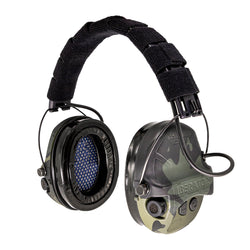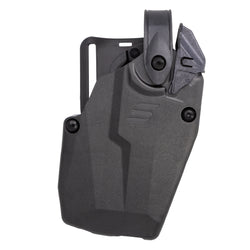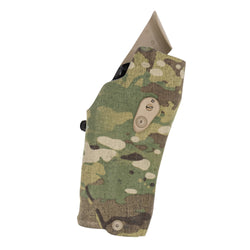Emergencies can happen when you least expect them, and being prepared with the right tools could mean saving a life, perhaps even a loved one. By equipping yourself with trauma kits, first aid kits, and proper training, you’re taking a proactive step toward being ready to act when it matters most. You’re your own first responder, and your readiness starts with having the essential tools within reach.
FIRST AID KITS vs. TRAUMA KITS
When it comes to first aid versus trauma kits, both serve critical but distinct purposes. A first aid kit is perfect for addressing everyday mishaps, like cuts, burns, or insect stings. It typically contains items such as bandages, antiseptic wipes, and cold packs—useful items for non-critical situations.
In contrast, a trauma kit is designed for life-threatening emergencies, such as severe bleeding or chest wounds. It includes advanced tools like tourniquets, hemostatic gauze, chest seals, and pressure bandages. If you’re choosing between the two, prioritize a trauma kit—it deals with emergencies that simply can’t wait for professional help.
WHAT IS AN IFAK?
Originally designed for military use, an IFAK (Individual First Aid Kit) a compact, purpose-built kit for addressing combat-related traumatic injuries. Over time, civilians have adopted similar kits as part of their emergency preparedness, often referring to them interchangeably with trauma kits.
While specific designs may differ, the shared objective of an IFAK or a trauma kit remains the same: equipping individuals with the tools needed to provide lifesaving care during medical emergencies. It empowers you to stabilize critical situations, potentially saving lives and fostering a sense of readiness and self-reliance.

THE RESPONSIBILITY OF BEING PREPARED
Carrying a trauma kit—or at least a tourniquet and gloves—is a responsibility that can save lives. For example, imagine you’re at a car accident where a victim is bleeding heavily from a leg wound. Having a tourniquet on hand could mean the difference between life and death before emergency services arrive.
Emergencies often demand that bystanders act as first responders, especially when professional assistance is delayed. When seconds count, rapid intervention with the right tools can make all the difference in preserving a life. Having even a small trauma kit ensures you’re ready to step in when it matters most.

BUILDING AN EDC TRAUMA KIT
An Everyday Carry (EDC) Trauma Kit is a crucial tool for managing life-threatening emergencies. Compact and portable by design, it contains essential items to address severe injuries effectively. Let’s look at the basics.
At the core of the kit are tourniquets, which are indispensable for stopping critical bleeding from extremities by halting blood flow to the affected area. To ensure reliability, it is advisable to choose tourniquets recommended by the Committee on Tactical Combat Casualty Care (CoTCCC), such as the CAT (Combat Application Tourniquet) or the SOF Tourniquet.

Another vital component is hemostatic gauze, which enhances clotting and swiftly controls severe bleeding in areas where a tourniquet cannot be applied. They’re not for use in penetrating thoracic or head trauma. Products like QuikClot and ChitoGauze are compact, efficient, and designed for ease of use.

Pressure bandages are equally indispensable, as they provide sustained pressure to control bleeding while stabilizing wounds. Options such as Israeli-style, OLAES, or ETD bandages offer versatility by combining dressing and compression in a single, user-friendly package. They are an essential part of any trauma kit, enabling responders to manage wounds effectively and prevent further complications.

Chest seals are critical for managing open chest wounds caused by gunshots or stab injuries. They address both entry and exit wounds, preventing air from entering the chest cavity—a situation that could lead to a life-threatening collapsed lung (pneumothorax).
Vented chest seals, such as the HyFin Vent, are particularly effective as they allow trapped air and fluids to escape while preventing re-entry, thus reducing the risk of tension pneumothorax.

Nitrile gloves are an essential addition to the kit. They serve as a protective barrier, preventing cross-contamination and shielding both the responder and the patient from exposure to bloodborne pathogens and other bodily fluids. Remember, gloves are the first item you put on and the last one you remove.

Trauma shears or a safety cutter are also important to include, as they allow quick and safe removal of clothing or gear to access wounds without causing further injury. Including a Sharpie marker is equally crucial to document the time a tourniquet was applied.
By including these fundamental components, an EDC Trauma Kit becomes a powerful tool for saving lives in critical situations.
CARRYING YOUR TRAUMA KIT
A trauma kit does you no good if it’s not readily accessible when you need it. That’s the whole purpose of EDC.
You have a lot of options to choose from. Ankle kits are a discreet and lightweight choice, ideal for daily wear as they can be easily concealed under pants. The concealable inside-the-waistband (IWB) IFAK pouches from Immediate Casualty Care are another great option. Belt pouches also provide convenient and quick access, attaching directly to your belt for effortless reach, although they’re typically less discreet.

For those who prefer a minimalist approach, pocket kits are a great option. These compact kits can be stored in the pockets of cargo pants or jackets, offering simplicity without sacrificing utility. If you need more storage space but still value portability, fanny packs or sling bags strike a perfect balance by providing extra capacity while remaining easy to carry.
Outdoor enthusiasts or individuals requiring additional supplies might benefit from chest rigs or backpacks. These options are versatile, allowing you to bring along more items for demanding scenarios. Vehicle storage, on the other hand, accommodates larger kits but comes with the trade-off of reduced portability when you’re far from your vehicle. Ultimately, your daily routine and environment should guide your decision, with accessibility and comfort taking top priority.

THE NEED FOR TRAINING
Possessing the right tools is only half the equation; knowing how to use them is what truly saves lives. Training equips you with the skills to handle high-pressure situations confidently. Regular practice and refresher courses are essential for maintaining proficiency. The best equipment is no good if you don’t know how to use it. The time to learn is not in an emergency.
STOP THE BLEED and the Red Cross are excellent resources that can direct you to training in your area, ensuring that you are ready to act when it matters most. Baer Solutions offers an excellent Medical Applications Course, which was covered earlier this year on CADRE Dispatch. Also, Dark Angel Medical offers its outstanding 2-day Direct Action Response Training at various locations around the country.
Having taken the Direct Action Response Training course myself, I can confidently recommend it. Participants receive BCON (Bleeding Control) certification from the American College of Surgeons and earn 16 hours of CEUs, accredited by CECBEMS, for NREMT EMT-Basics, Advanced EMTs, and Paramedics. Regardless of your current level of training, you will gain invaluable knowledge and skills.

FINAL THOUGHTS
Emergencies don’t wait for preparation; they demand it. By getting an EDC trauma kit and investing in training, you equip yourself to protect not just your own life but also the lives of others. Your readiness and quick response can make the difference between life and death. Start preparing today—because when seconds count, you’re the first responder.









